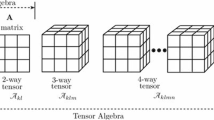Abstract
In this paper, we propose a novel method, called random subspace method (RSM) based on tensor (Tensor-RS), for face recognition. Different from the traditional RSM which treats each pixel (or feature) of the face image as a sampling unit, thus ignores the spatial information within the face image, the proposed Tensor-RS regards each small image region as a sampling unit and obtains spatial information within small image regions by using reshaping image and executing tensor-based feature extraction method. More specifically, an original whole face image is first partitioned into some sub-images to improve the robustness to facial variations, and then each sub-image is reshaped into a new matrix whose each row corresponds to a vectorized small sub-image region. After that, based on these rearranged newly formed matrices, an incomplete random sampling by row vectors rather than by features (or feature projections) is applied. Finally, tensor subspace method, which can effectively extract the spatial information within the same row (or column) vector, is used to extract useful features. Extensive experiments on four standard face databases (AR, Yale, Extended Yale B and CMU PIE) demonstrate that the proposed Tensor-RS method significantly outperforms state-of-the-art methods.













Similar content being viewed by others
References
Fukunaga K (2013) Introduction to statistical pattern recognition. Academic Press, London
Turk M, Pentland A (1991) Eigenfaces for recognition. J Cogn Neurosci 3(1):71–86
Lu J, Tan Y-P (2011) Improved discriminant locality preserving projections for face and palmprint recognition. Neurocomputing 74(18):3760–3767
An L, Kafai M, Bhanu B (2013) Dynamic bayesian network for unconstrained face recognition in surveillance camera networks. IEEE J Emerg Sel Top Circuits Syst 3(2):155–164
Kafai M, An L, Bhanu B (2014) Reference face graph for face recognition. IEEE Trans Inform Forensics Secur 9(12):2132–2143
Ding C, Xu C, Tao D (2015) Multi-task pose-invariant face recognition. IEEE Trans Image Process 24(3):980–993
Moeini A, Moeini H (2015) Real-world and rapid face recognition towards pose and expression variations via feature library matrix. IEEE Trans Inf Forensics Secur 10(5):969–984
Wang X, Tang X (2005) Subspace analysis using random mixture models. In: IEEE Computer Society conference on computer vision and pattern recognition, 2005, CVPR 2005. IEEE
Zhang X, Jia Y (2007) A linear discriminant analysis framework based on random subspace for face recognition. Pattern Recognit 40(9):2585–2591
Yu G et al (2012) Semi-supervised classification based on random subspace dimensionality reduction. Pattern Recognit 45(3):1119–1135
Nanni L, Lumini A (2008) Random subspace for an improved biohashing for face authentication. Pattern Recognit Lett 29(3):295–300
Zhu Y, Liu J, Chen S (2009) Semi-random subspace method for face recognition. Image Vis Comput 27(9):1358–1370
Chawla NV, Bowyer KW (2005) Random subspaces and subsampling for 2-d face recognition. In: IEEE computer society conference on computer vision and pattern recognition, 2005. CVPR 2005. IEEE
Yang J et al (2004) Two-dimensional PCA: a new approach to appearance-based face representation and recognition. IEEE Trans Pattern Anal Mach Intell 26(1):131–137
Li M, Yuan B (2005) 2D-LDA: a statistical linear discriminant analysis for image matrix. Pattern Recognit Lett 26(5):527–532
Ye J, Janardan R, Li Q (2004) Two-dimensional linear discriminant analysis. In: Advances in neural information processing systems, NIPS 2004, MIT Press
Hu D, Feng G, Zhou Z (2007) Two-dimensional locality preserving projections (2DLPP) with its application to palmprint recognition. Pattern Recognit 40(1):339–342
He X, Cai D, Niyogi P (2005) Tensor subspace analysis. In: Advances in neural information processing systems, NIPS 2005. MIT Press
Zhang W, Lin Z, Tang X (2009) Tensor linear Laplacian discrimination (TLLD) for feature extraction. Pattern Recognit 42(9):1941–1948
Nguyen N, Liu W, Venkatesh S (2007) Random subspace two-dimensional PCA for face recognition. In: Advances in multimedia information processing—PCM 2007. Springer, pp 655–664
Sanguansat P et al (2007) Two-dimensional random subspace analysis for face recognition. In: International symposium on communications and information technologies, 2007. ISCIT’07. IEEE
Wang J et al (2010) Multilinear principal component analysis for face recognition with fewer features. Neurocomputing 73(10):1550–1555
Zou J, Ji Q, Nagy G (2007) A comparative study of local matching approach for face recognition. IEEE Trans Image Process 16(10):2617–2628
Ho TK (1998) The random subspace method for constructing decision forests. IEEE Trans Pattern Anal Mach Intell 20(8):832–844
Gottumukkal R, Asari VK (2004) An improved face recognition technique based on modular PCA approach. Pattern Recognit Lett 25(4):429–436
Yan S et al (2007) Element rearrangement for tensor-based subspace learning. In: IEEE conference on computer vision and pattern recognition, 2007. CVPR’07. IEEE
Cai D et al (2007) Learning a spatially smooth subspace for face recognition. In: IEEE conference on computer vision and pattern recognition, 2007. CVPR’07. IEEE
Martinez AM (1998) The AR face database. CVC technical report, 24
Tan K, Chen S (2005) Adaptively weighted sub-pattern PCA for face recognition. Neurocomputing 64:505–511
Kumar R, Banerjee A, Vemuri BC (2009) Volterrafaces: discriminant analysis using Volterra kernels. In: IEEE conference on computer vision and pattern recognition, 2009. CVPR 2009. IEEE
Lee K-C, Ho J, Kriegman D (2005) Acquiring linear subspaces for face recognition under variable lighting. IEEE Trans Pattern Anal Mach Intell 27(5):684–698
Acknowledgments
This work was fully supported by the NUAA Research Funding (No. NS2014100).
Author information
Authors and Affiliations
Corresponding author
Rights and permissions
About this article
Cite this article
Zhu, Y., Xue, J. Face recognition based on random subspace method and tensor subspace analysis. Neural Comput & Applic 28, 233–244 (2017). https://doi.org/10.1007/s00521-015-2052-3
Received:
Accepted:
Published:
Issue Date:
DOI: https://doi.org/10.1007/s00521-015-2052-3




